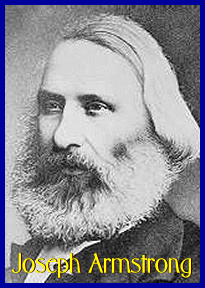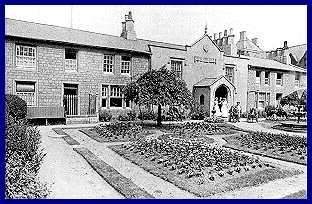Joseph Armstrong
A worthy successor
When he died suddenly in 1877 he had been the Great Western Railway's locomotive superintendent for just 13 years, but the impact he made on the company and its heartland, Swindon, was profound. Though it is Gooch who is remembered as 'the father of Swindon works' and in many ways the father of modern Swindon, in Armstrong he found a perfect successor whose brilliant management ability saw the town through another rapid period of growth. Armstrong was a great engineer in his own right and a highly practical one, yet it is for his sympathetic management of developments at Swindon at an extremely difficult time that he is most remembered. The news of his unexpected death was greeted with an outpouring of real grief on the streets of Swindon, followed by probably its biggest ever funeral. According to Astill's Original Swindon Almanac of 1878, it 'cast a gloom over the entire community'. What kind of man could cause such a reaction from ordinary workers? Armstrong was born at Bewcastle, Cumberland, on 21 September 1816, the same year as Gooch, but had to wait until he was 48-years-old before inheriting Gooch's post as locomotive superintendent. His first experience was as a driver, right at the birth of railways on the famous Stockton and Darlington and the Liverpool and Manchester lines. By 1845 he had moved on to several other railways and it was as locomotive superintendent of the amalgamated Shrewsbury & Birmingham and Shrewsbury & Chester Railways that he probably first came to the attention of Gooch. When that railway was merged into the GWR in 1854, Armstrong became superintendent of the northern division at Wolverhampton. Ten years later, following Gooch's resignation, he went to Swindon as chief superintendent - not only of the locomotive side, but also the new carriage and wagon departments. There could hardly have been a more difficult time for anyone to take charge. Firstly, the GWR was in serious financial straits and, until new chairman Gooch put the books in order, Armstrong needed to work within tight budgets. Yet Swindon Works was also expanding with the building of new carriage and wagon works, which began in 1868, and improvements to other shops. This major project would have consumed most of the time and all of the energy of lesser men than Armstrong. Yet, just as Gooch had before him, Armstrong recognised his responsibilities to the social scene in Swindon and worked tirelessly for the good of each of the 13,000 workers under his control throughout the system. He was a dedicated Wesleyan Methodist and lay preacher. "Consequently," wrote Alan S Peck in his difinitive history of Swindon Works, "his inherent attitude to the social and moral conditions of the time was very enlightened, as was his relationship with his fellow men, whether employer or employee." And he dealt in actions, not words. He actively and enthusiastically supported the New Swindon Local Board, the Mechanics Institute, the Medical Fund, the Sick Fund Society and the New Swindon Permanent Benefit Building and Investment Society, among others. In 1866 he helped to form the Swindon Water Works Company so that the town could at last have an adequate water supply and the New Swindon Educational Board was formed in order for the GWR to build schools. The year 1868 saw the instigation of a 'Children's Fete' which survived until the Second World War and in 1869 swimming baths were opened for the use of the workers. Two years later, the Medical Fund Society Hospital, for which Gooch had laid the foundations, was complete (see picture). No wonder Armstrong became a popular local celebrity and a true man of the people.
It is almost easy to forget that he also had a railway to run and engines to design. Not surprisingly given the limitations of budget and the complication of having to work to the dual disciplines of broad and narrow gauge stock, Armstrong's designs were simple, but they were also solid, practical and reliable. And output during this time was phenomenal. From 1869, when the works was in full production, until 1877 when he died, Armstrong oversaw the manufacture of around 600 locomotives, 2,000 carriages and no less than 10,000 wagons. Around 40 of his engines were still running at the end of the Second World War. The works were transformed from a straightforward, mainly repair installation to a self-supporting engineering factory, complete with new carriage and wagon works and expanding locomotive production. Not only was it done from a position of near bankruptcy, but even achieved against a backdrop of reduced working hours and comparatively high pay. Joseph Armstrong moved mountains and he is a giant of Swindon's railway heritage.
Though the Mechanics Institute was formed under Gooch, it was under Armstrong that it bloomed and Swindon men were probably the best educated manual workers in the world. As Richard Jefferies noted: "Where one book is read in agricultural districts, fifty are read in the vicinity of the factory."
Armstrong was a benevolent man, but refused to allow cabs for engine drivers because he was convinced from his own experiences as a driver that it would lead to drowsiness. The most famous locomotive produced during Armstrong's reign was called Queen, which was built in 1877, the year of his death. During his early years, Armstrong was a junior workmate of the great George Stephenson who, coincidentally, was a frequent visitor to the childhood home of Armstrong's predecessor, Sir Daniel Gooch. After Armstrong's death, workers clubbed together to buy a lifeboat for the RNLI as a memorial to him. It was stationed at Cadgwith, Cornwall, which became the favourite holiday haunt of senior GWR officers. Joseph Armstrong is buried in the south-east corner of St Mark's Church. The Swindon Works hooter was first heard during Armstrong's time. It was installed in 1872. Armstrong was a benevolent man, but refused to allow cabs for engine drivers because he was convinced from his own experiences as a driver that it would lead to drowsiness. The most famous locomotive produced during Armstrong's reign was called Queen, which was built in 1877, the year of his death. During his early years, Armstrong was a junior workmate of the great George Stephenson who, coincidentally, was a frequent visitor to the childhood home of Armstrong's predecessor, Sir Daniel Gooch. After Armstrong's death, workers clubbed together to buy a lifeboat for the RNLI as a memorial to him. It was stationed at Cadgwith, Cornwall, which became the favourite holiday haunt of senior GWR officers. Joseph Armstrong is buried in the south-east corner of St Mark's Church. The Swindon Works hooter was first heard during Armstrong's time. It was installed in 1872. |
|
||||||||
|
||||||||
|
||||||||
|
||||||||
|
||||||||
|
||||||||
|
||||||||
|
||||||||
|
||||||||


















